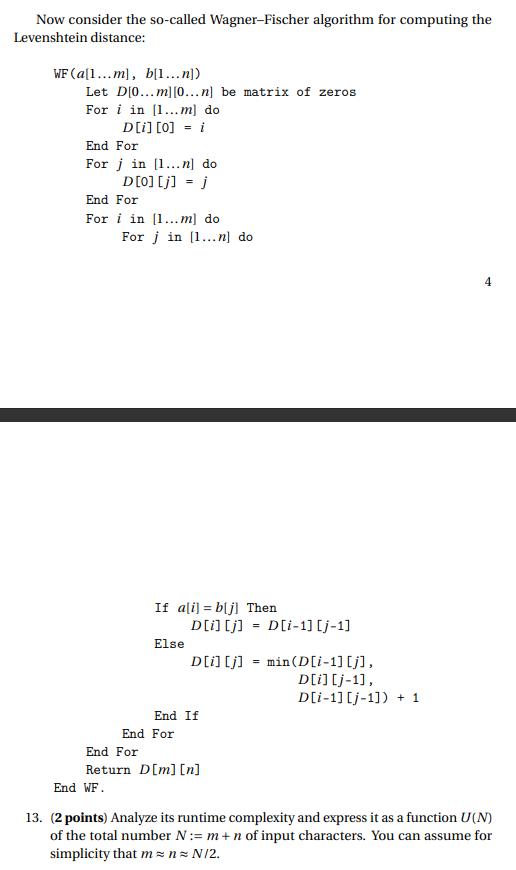Question
Now consider the so-called Wagner-Fischer algorithm for computing the Levenshtein distance: WF (a[1...m], b[1...n]) Let D[0...m][0...n] be matrix of zeros For i in [1...m]

Now consider the so-called Wagner-Fischer algorithm for computing the Levenshtein distance: WF (a[1...m], b[1...n]) Let D[0...m][0...n] be matrix of zeros For i in [1...m] do D[i][0] = i End For For j in [1...n] do D[0][j] End For = j For i in [1...m] do For jin [1...n] do If a[i] b[j] Then D[i][j] = D[i-1] [j-1] Else D[i][j] = min(D[i-1][j], D[i][j-1], D[i-1][j-1]) + 1 End If End For End For 4 Return D[m] [n] End WF. 13. (2 points) Analyze its runtime complexity and express it as a function U(N) of the total number N:=m+n of input characters. You can assume for simplicity that m = n = N/2.
Step by Step Solution
There are 3 Steps involved in it
Step: 1
The WagnerFischer algorithm for computing the Levenshtein distance has a ...
Get Instant Access to Expert-Tailored Solutions
See step-by-step solutions with expert insights and AI powered tools for academic success
Step: 2

Step: 3

Ace Your Homework with AI
Get the answers you need in no time with our AI-driven, step-by-step assistance
Get StartedRecommended Textbook for
Microeconomics An Intuitive Approach with Calculus
Authors: Thomas Nechyba
1st edition
538453257, 978-0538453257
Students also viewed these Programming questions
Question
Answered: 1 week ago
Question
Answered: 1 week ago
Question
Answered: 1 week ago
Question
Answered: 1 week ago
Question
Answered: 1 week ago
Question
Answered: 1 week ago
Question
Answered: 1 week ago
Question
Answered: 1 week ago
Question
Answered: 1 week ago
Question
Answered: 1 week ago
Question
Answered: 1 week ago
Question
Answered: 1 week ago
Question
Answered: 1 week ago
Question
Answered: 1 week ago
Question
Answered: 1 week ago
Question
Answered: 1 week ago
Question
Answered: 1 week ago
Question
Answered: 1 week ago
Question
Answered: 1 week ago
Question
Answered: 1 week ago
Question
Answered: 1 week ago
Question
Answered: 1 week ago
Question
Answered: 1 week ago
View Answer in SolutionInn App



